MNT group Project PDF

| Title | MNT group Project |
|---|---|
| Author | Eva Copeland |
| Course | Medical Nutrition Therapy Ii |
| Institution | Appalachian State University |
| Pages | 9 |
| File Size | 192.2 KB |
| File Type | |
| Total Downloads | 9 |
| Total Views | 131 |
Summary
MNT Group Project ...
Description
Case Study 23: Ischemic Stroke MNT 1 Group 8: Evie Copeland, Kelsey Ziegler, & Caitlin Flatley 6. Definition of dysphagia ● Difficulty swallowing (dysphagia) means it takes more time and effort to move
food or liquid from your mouth to your stomach. Dysphagia may also be associated with pain. In some cases, swallowing may be impossible ○ Primary nutrition implication: Stroke http://www.mayoclinic.org/diseases-conditions/dysphagia/basics/definition/con-20033444 7. Four phases of swallowing: ● Oral preparation: food is manipulated (masticated if solid) into a cohesive unit in preparation for the remaining phases of swallow ○ Chewed/mixed with saliva to form a bolus ○ Food has been softened and mixed with saliva and is sitting on the dorsum of the tongue ● Oral transit: “oral propulsion” or “transit stage” ○ Food is moved back through the mouth with a front-to-back squeezing ○ Performed primarily by the tongue ○ Moving upward/forward, the tip of the tongue comes into contact with the hard palate; area of tongue-palate contact expands posteriorly, which pushes food into the oropharynx ● Pharyngeal: beginning of the swallowing response ○ Food enters the upper throat area (above voice box) ○ Soft palate elevates ○ Epiglottis closes off the trachea, as the tongue moves backwards and the pharyngeal wall moves forward ■ Forces food down the esophagus ● Esophageal: food bolus enters the esophagus and is transported directly to the stomach ○ Bolus is moved to the stomach by a squeezing action of the throat muscle http://coc.unm.edu/common/training/aspiration2013fedor.pdf
8. Solid Foods & Liquid Foods ● 3 Levels of Solid Foods ○ NDD Level 1: Dysphagia-Pureed (homogenous, very cohesive, pudding-like, requiring very little chewing ability) ○ NDD Level 2: Dysphagia-Mechanically Altered (cohesive, moist, semi solid foods, requiring some chewing) ○ NDD Level 3: Dysphagia-Advanced (soft foods that require more chewing ability). ● 4 Levels of Fluid Consistency ○ Thin: 1-50 centiPoise (cP)
○ Nectar-thick: 51-350 cP ○ Honey-thick: 351-1,750 cP ○ Spoon-thick: >1,750 cP 5 http://thickit.com/3-things-you-should-know-about-the-national-dysphagia-diet/ 9. Recommendation ● NDD Level 1: Dysphagia-Pureed due to reduced esophageal peristalsis and inability to the inability to move food towards back of the throat and to force food down the esophagus. ● Nectar-thick consistency 10. Swallowing Assessment ● Components ○ Locus of the patient's dysphagia - whether it is oral or pharyngeal ○ Patient's readiness for a radiographic study ○ Patient's ability to accept food into the mouth ○ Oral reaction to placement of various tastes, temperatures, and textures ○ Presence of any oral apraxia, abnormal oral reflexes, such as tonic bite ○ Postural and behavioral needs of the patient ○ Laryngeal function may affect airway protection and aspiration during the swallow ○ Coughing status ○ Best position of food in mouth ○ Oral sensitivity ○ Best food consistency ○ Selection of optimum swallowing instructions ● Bedside Clinical Exam ○ Designed to provide data for use in diagnosis and treatment planning. ○ 2 parts of the exam: ■ The preparatory exam with no actual swallows. ■ The initial swallowing exam when actual swallowing is attempted and physiology is observed. ● Backgrounds and Training Requirements: ○ Degree requirements ■ A master's degree, such as a Master of Arts, Master of Education, or Master of Science, is the entry level credential for working in the field. ○ Education Field of Study ■ Speech pathology ■ Communication sciences ○ Prerequisites ○ Completion of a bachelor's degree program with coursework in human anatomy ○ Language, speech development, and speech disorders. ○ Audiology, linguistics, phonology, the science of sound ○ GPA: Minimum of 3.0 GPA ○ Key Skills
■ ■
Evaluate, diagnose and treat speech and swallowing disorders Provide therapy including vocalization exercises and muscle development exercises ■ Teach alternative communication methods such as sign language to nonverbal patients ○ Licensure/Certifications ■ Almost all states require licensure ■ Professional certification is available from the American SpeechLanguage-Hearing Association http://www.d.umn.edu/~mmizuko/5200/bedside.htm 11. Modified Barium Swallow/Fiberoptic Endoscopic Evaluation of Swallowing ● A modified barium swallow (MBS) is a fluoroscopic procedure designed to determine whether food or liquid is entering a person’s lungs (aspiration). During this procedure, the pharynx and esophagus are made visible through X-ray by the liquid suspension barium sulfate. ○ Video: https://www.youtube.com/watch?v=CwPW5Y7dtkU ●
A fiberoptic endoscopic evaluation of swallowing (FEES) is the preferred method for evaluating swallowing function. In FEES, a flexible fiberoptic endoscope is inserted intranasally into the person’s hypopharynx where the clinician can clearly view the anatomical structures of the airway and swallowing mechanisms. The patient is then walked through various swallowing techniques so that the clinician an evaluate the patient’s swallowing integrity. ○ Video: https://www.youtube.com/watch?v=j2pNt53XlFM
12. Gel Thickeners & Powder Thickeners ● Description ○ There are numerous gel thickeners and powder thickeners that can be added to liquids or pureed foods to change the consistency. Food/fluid thickeners promote safety when consuming food and beverages for those with dysphagia. Most thickeners are made with starch but gum-based products are becoming more common. ○ Use of thickeners ■ Modified textures are easier to swallow; thickened fluids enter the pharynx slowly ■ Allows time for the pathway to the lungs to be closed off to avoid aspiration and choking ●
Example of thickener ○ Thick & Easy ■ Manufactured by Hormel ■ Available as a Clear Food Thickener, Honey Packets, Nectar Packets, Food Thickener, or Fortified Thickener
■
○
Thick & Easy Clear Instant Food & Beverage Thickener - Honey 100/2.2g ● Ingredients ○ Maltodextrin, Xanthan Gum, Carrageenan, Erythritol ● Contents of stick measure to thicken 4 fl oz of liquid ● Add one sick thickener into empty dry glass ● Add 4 fl oz of desired liquid and whisk/stir quickly until dissolved Source: http://www.hormelhealthlabs.com/2colTemplate_product.aspx? page=CO_TE_Beverages&cond_id=117&cat_id=162
13. PT BMI ● PT usual body weight is approximately 165 lbs. ● Calculate and interpret her BMI ● 62 in x 2.54 = 157.48cm/ 100 = 1.5748 m ● 165 lbs/2.2= 75kg ● BMI= 30.24kg/m2 14. PT Estimated Energy & Protein Needs ● Energy Requirements ○ Mifflin: (9.99* 75 kg) +(6.25 *157 cm) -(4.92 * 77 age of years) -161 749.25 + 981.25 - 278.84 -161 =1,190.66 kcal * 1.5 (ADL → used this because she is not on bed rest, but still living comfortably ) = 1,786 kcal ● Protein requirements: ○ Used obese: 1.0-1.7 g/kg 75 kg *1.0g= 75 g of protein 75 kg * 1.7g= 125.5 g of protein = 75 grams -125.5 grams of protein total ● Weight loss or weight gain included in estimate ○ Weight loss should be included later on because she is slightly obese by 0.2. ● Rationale ○ Because Ruth Noland’s BMI was 30.2 and she needs to lose weight and doesn’t need to be taking in anymore energy calories than necessary 17. Estimate Mrs.Noland’s fluid needs using the following methods: weight, age and weight, and energy needs ● Method 1 (weight): 25-35mL/kg of body weight ○ 1,875mL - 2,625mL of fluid daily ● Method 2 (age and weight): adult >75 years: 25mL/kg of body weight ○ 1,875mL of fluid daily ● Method 3 (energy needs): 1 mL:1 kcal ○ 1,786kcal → 1,786mL of fluid daily 18. Which method of fluid estimation appears most reasonable for Mrs. Noland? Explain. ● The first method using just her weight is the most reasonable for Ruth because it is a
range rather than a specific figure. With a larger fluid requirement, Ruth will be able to meet more of her daily energy needs from fluids. 19. PT Abnormal Labs ● Cholesterol ○ Reason for abnormality ■ Consistent consumption of high saturated fat/cholesterol products ○ Clinical significance ■ Total cholesterol of 200-239 mg/dL is borderline high ■ PT value: 210 mg/dL ○ Nutritional Implication: Excessive consumption of foods high in cholesterol ● HDL-C ○ Reason for abnormality ■ Lack of physical activity ○ Clinical significance ■ HDL < 40 mg/dL = major risk factor for heart disease ■ PT value: 40 mg/dL ■ Nutritional Implication: Excessive consumption of foods high in saturated fats ● LDL-C ○ Reason for abnormality ■ PT is 77 years of age and postmenopausal; LDL rises after estrogen levels decrease after menopause ■ High consumption of saturated fat through dairy products and margarine ○ Clinical significance ■ HDL 130-159 mg/dL = borderline high ■ PT value: 155 mg/dL ○ Nutritional Implication: Excessive consumption of foods high in saturated fats ● LDL/HDL ratio ○ Reason for abnormality: High LDL and low HDL leading to major risk of heart disease. ○ Clinical significance: ■ PT value: 3.875 ■ Normal for females: 100 mg/dL, HDL cholesterol 150 mg/dL and frequent food preparation with added fat. 21. For each of the two PES statements that you have written, establish an ideal goal (based on the signs and symptoms) and an appropriate intervention (based on the etiology). 1. Undergo rehabilitation with speech therapist to re-establish appropriate swallowing function. The intervention is to collaborate with the speech therapist to incorporate honey thickened liquids until she regains her swallowing function. 2. Work on finding better options for foods or food additions to decrease fat intake. Nutrition education (E-1) to educate on fats and high fat content foods as well as how to read a food label and appropriate meal planning. 22. Definitions of Characteristics of Food Term
Definition
Example
Consistency
Degree of firmness or thickness, density, viscosity, or resistance to movement or separation of constituent particles;
Clear liquid Full liquid - liquid at body temperature Blenderized liquid - smooth consistency
Texture
The way that a food or drink feels in your mouth
Regular diet Mechanical soft Pureed diet
Viscosity
The property of resistance to flow in a fluid or semifluid
Honey-like fluids (viscous) Nectar-like (medium viscous) Spoon-thick (high viscosity)
23. Using Mrs. Noland’s 24-hour recall, make suggestions for consistency changes or food substitutes (if needed) to Mrs. Noland and her family. Consistency Change: -To drink more water throughout the day, 25mL * 75kg= 1,875 mL 35mL * 75kg=2,625 mL 1,875-2,625 mL total Food Substitutes:
-Orange juice: Instead of Orange Juice have water -Raisin Bran: Instead of Raisin Bran have a Fibre 1 Cereal or Bar -2% milk: Instead of 2% milk use 1% milk in her cereal and coffee -Banana: No changes with eating a banana, that adds potassium to her diet -Coffee: No changes with drinking coffee, but only have it black and limit the intake to 2 cups per day -Sweetener: instead of sweetener add local honey to her coffee instead of sweeteners that still add the sweet taste but aren’t as bad for her -Chicken tortellini soup: instead of chicken soup, have a low sodium vegetable -Saltine Crackers: instead have a whole grain cracker instead that provides more fiber -Canned pears: instead of having canned peaches, have a cup of fresh pears -Iced tea: instead of having sweet tea have just unsweetened tea with 1-2 splendas -Baked Chicken: No changes to baked chicken, except to remove the skin on the outside because of the fat content -Baked potato: instead of baked potato have a baked sweet potato with no margarine to add potassium to the diet -Steamed Broccoli: No changes to steamed broccoli -Margarine: instead of margarine, buy a non-hydrogenated with vegetable oil if she has to buy it (Sterols), olive oil would be a good substitute as well -Canned peaches: instead have a fresh peach in replacement to remove added sugars
24. Describe Mrs Noland’s potential nutritional problems upon discharge. What recommendations could you make to her husband to prevent each problem you identified? How would you monitor her progress? ●
Upon discharge, Mrs Noland will continue to have difficulty with swallowing until she is able to continue work with a speech pathologist to transition back towards proper swallowing techniques. Along with food consistency modifications, Mrs Noland needs to understand that her added fats can be detrimental to her health and it is important that she modifies her fat intake. For example, she needs to find alternatives to her sweeteners and margarine additions or she should not add sweeteners at all. For her benefit, I think it would be helpful to Mrs Noland if her husband would remove such sweeteners and margarines from the household prior to her hospital discharge. This way she cannot be tempted. He should replace the margarine with olive oil based margarine or pure olive oil. To monitor her progress, I would like to have bi-weekly follow ups with Mrs. Noland to ensure that she is bettering her nutritional lifestyle.
25. Would Mrs. Noland be an appropriate candidate for a stroke rehabilitation program? Why or why Not? Yes, because of her swallowing difficulty, and she has no education on fat intake. Due to her lab results, they are abnormal for blood lipid levels; therefore, she needs education on fat content to help prevent her from developing another stroke in the future.
References
●
Video Links: https://www.youtube.com/watch?v=CwPW5Y7dtkU https://www.youtube.com/watch?v=j2pNt53XlFM
●
Fedor, C. (2013). Review of Normal Swallow and Aspiration. University of New Mexico School of Medicine. Retrieved from: http://coc.unm.edu/common/training/aspiration2013fedor.pdf
●
Thickit. 3 things you should know about the national dysphagia diet. Dysphagia Nutrition Solutions Thick It. 2014. http://thickit.com/3-things-youshould-know-about-the-national-dysphagia-diet/
●
Hormonal Health Labs. Thick and Easy Thickened Beverages. Retrieved From http://www.hormelhealthlabs.com/2colTemplate_product.aspx? page=CO_TE_Beverages&cond_id=117&cat_id=162
●
Mayo Clinic Staff. Diseases and conditions dysphagia: definitions. Mayo Clinic 2017 Reviewed By: http://www.mayoclinic.org/diseases-conditions/dysphagia/basics/definition/con-20033444...
Similar Free PDFs

MNT group Project
- 9 Pages
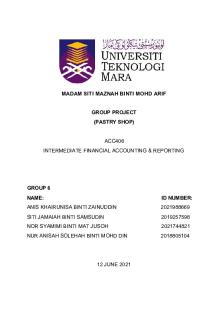
Group Project Account ( Group 6)
- 21 Pages
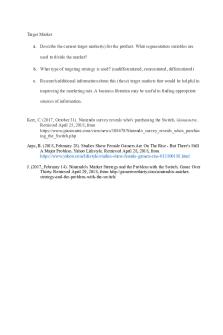
Group Project- Target Market
- 4 Pages
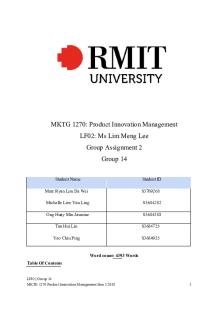
PIM Group Project 2
- 68 Pages
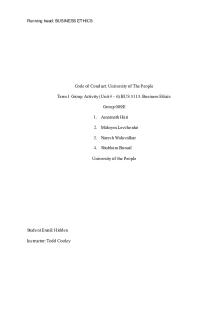
Group Project 009E Final
- 21 Pages
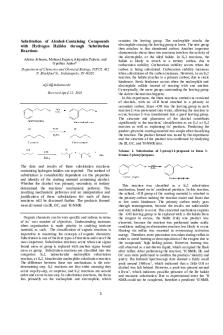
Group Project JOC Note
- 4 Pages

Group Project Proposal
- 1 Pages
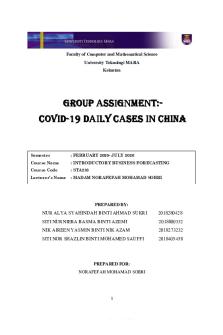
Group Project STA 233
- 33 Pages
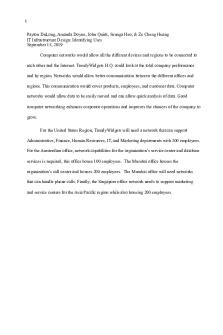
IST Group Project
- 19 Pages

Group project guidelines
- 1 Pages

group project sta108
- 55 Pages

CSR Group Project ASM401
- 18 Pages

Victoria\'s Secret Group Project
- 11 Pages

CSC264 Group Project
- 8 Pages

Project MAT575 Group 1
- 9 Pages

Group project-TB
- 31 Pages
Popular Institutions
- Tinajero National High School - Annex
- Politeknik Caltex Riau
- Yokohama City University
- SGT University
- University of Al-Qadisiyah
- Divine Word College of Vigan
- Techniek College Rotterdam
- Universidade de Santiago
- Universiti Teknologi MARA Cawangan Johor Kampus Pasir Gudang
- Poltekkes Kemenkes Yogyakarta
- Baguio City National High School
- Colegio san marcos
- preparatoria uno
- Centro de Bachillerato Tecnológico Industrial y de Servicios No. 107
- Dalian Maritime University
- Quang Trung Secondary School
- Colegio Tecnológico en Informática
- Corporación Regional de Educación Superior
- Grupo CEDVA
- Dar Al Uloom University
- Centro de Estudios Preuniversitarios de la Universidad Nacional de Ingeniería
- 上智大学
- Aakash International School, Nuna Majara
- San Felipe Neri Catholic School
- Kang Chiao International School - New Taipei City
- Misamis Occidental National High School
- Institución Educativa Escuela Normal Juan Ladrilleros
- Kolehiyo ng Pantukan
- Batanes State College
- Instituto Continental
- Sekolah Menengah Kejuruan Kesehatan Kaltara (Tarakan)
- Colegio de La Inmaculada Concepcion - Cebu